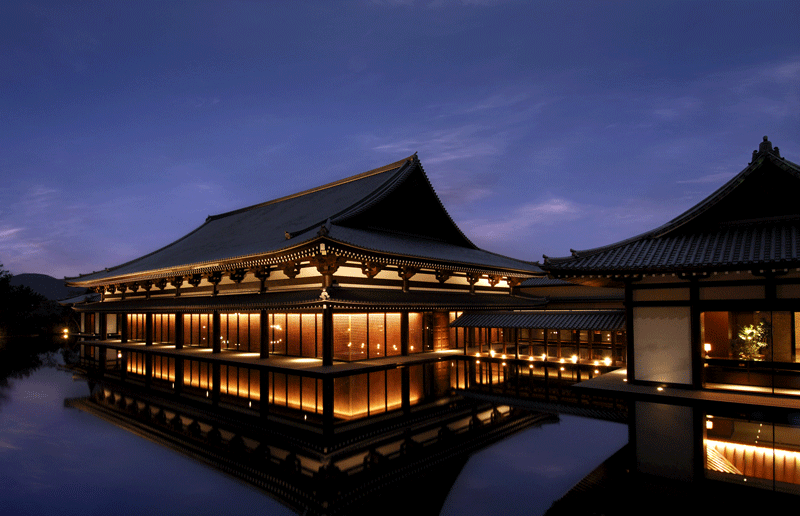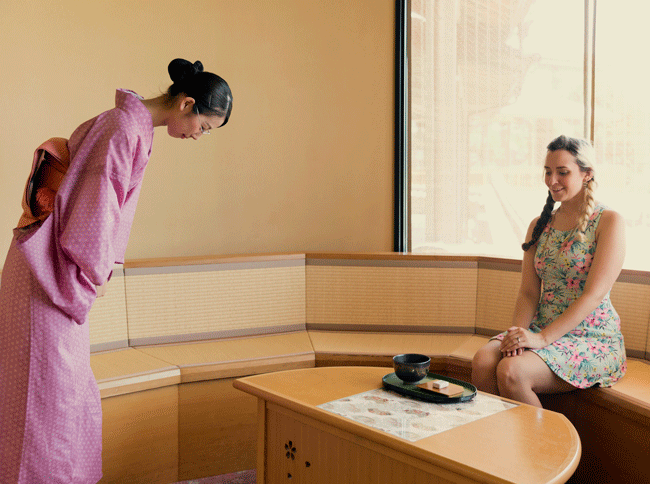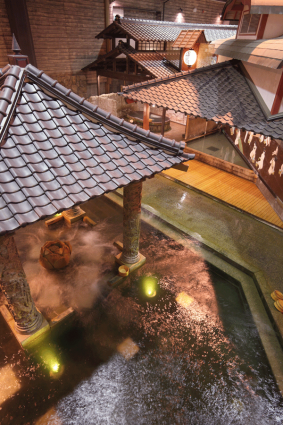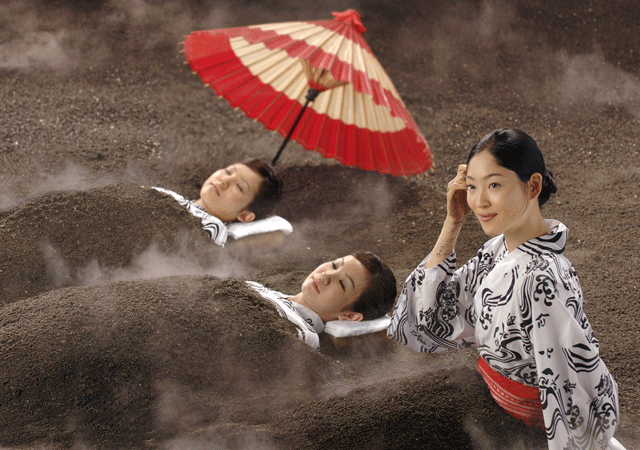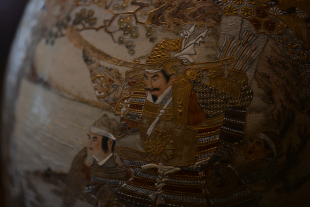Consistently ranked among the country’s top ryokan, Hakusuikan rivals small cities with its list of attractions.
“My father built Hakusuikan over 60 years ago, in 1947. It’s evolved quite a bit since it was first opened, and I plan to go even further with it,” says Tadataka Shimotakehara as he speaks about the family business. He has already gone quite a long way. After joining the Mitsubishi Corporation after graduation, Shimotakehara was stationed overseas. He lived in Manhattan and later studied Russian and Political Science at Harvard, and eventually moved to Russia and worked at a chemical plant.
His ryokan is a reflection of this broad international experience—it’s an expansive, 69-acre campus of surprises around every corner. Even a weeklong stay is not enough time to experience all Shimotakehara provides for his guests.
Luxuriate in Variety
Hakusuikan combines what his father established, a solid infrastructure based on southern Okinawan traditions (“It was all the rage in the 50s”), mixed with global influences from more recent decades. “I want to provide Japanese guests with an experience that makes them feel removed from Japan.”
Shimotakehara has reached that goal in a number of ways. There are just under twenty restaurants, dining halls, cafes, and lounges in the complex, each with a different theme and a variety of cuisines. If you feel like having a traditional Japanese breakfast, you can do just that, then enjoy Western for lunch and Chinese for dinner. There are high-end restaurants on-site as well, including the highly acclaimed Fenice Italian restaurant. Surrounded by a moat, and lit by torches at night, it’s a considerably romantic place.
Other hints of globalism can be seen throughout the halls. Traditional Japanese art mixes with pieces from overseas. Turtles may be crawling in one hallway, while another might feature an entire hall of plants. Doors are covered in hand-painted exotic flowers. Hakusuikan hosts traditional Japanese weddings, and ceremonies from other religious backgrounds at different venues on site. Guests can find multiple languages on sign posts, and get help in the language they are most comfortable in from staff.
“People are obsessed with pairing Japan with the idea of omotenashi. However, from my experience, Japan is not the only country that possesses it. In fact, I think much of the world is beating Japan at omotenashi.” His primary example is of staff at a Thailand resort speaking multiple languages, and knowing the art of subtle assistance, who succeed at timely approaches.
Today, his staff receives lessons on other languages and etiquette with foreign guests. Many guests come from nearby Hong Kong, South Korea, and Taiwan. Hakusuikan would love to invite more Western guests to experience the hospitality and luxury of the resort—recently, a French magician was hired to entertain guests on certain days. During summer, fireworks are lit off downtown Ibusuki three days a week. Live music is played out on the pool deck during warm summers, and storytellers and university lecturers put on shows monthly. Guests who are in for a bit of water adventure can head out into the water for trip on a nimble catamaran, helmed by local staff.
Bathing Beauty
Of course, Hakusuikan is, first and foremost, an onsen ryokan. There are onsen options everywhere. The main hot springs hall is enormous. It takes a bit of walking around the maze-like campus to find it at first, but the journey is worth it. While much of the hotel replicates an Edo-style building, the onsen hall imitates a Genroku (Golden Age of Japan: 1688–1704) style; there is a tall wooden bridge over a large hot spring, and smaller hot springs are divided into small rooms that look like traditional bars, with lanterns hanging over them and Meiji-jidai-style artwork covering all of the walls. Plants grow everywhere, making it feel more like a small town than a bathing area.
In a separate area, Hakusuikan offers its own famous Kagoshima sand bath. The traditional sand bath dates back 200 years, and is a considered a natural exfoliating process that helps “sweat out” toxins in the body. Almost five kilograms of hot sand are poured evenly across the body (keeping the yukata on, of course). With temperatures reaching nearly 70 degrees Celsius (!), it can be a little too hot for guests, so the time limit is set from 10 to 15 minutes. “Water from the onsen runs about 70 cm below the sand, and is layered with more sand underneath for stability. Every day, we cycle through [the equivalent of] 450 tons of fresh onsen water.” It’s a must for guests to try out a sand bath while visiting Kagoshima. “We have our sand baths indoors, so that guests can do it 365 days a year. Most other sand baths are weather dependent, so we removed that inconvenience.”
Nearby, after sweating it out, guests can relax outdoors in one of the beachfront hammocks under a palm tree, or take a walk in the pine forest and spot rabbits hopping around. Or, they could have a drink at their own “Shochu Dyojo,” where staff have collected over 400 kinds of Kagoshima shochu brands. If that doesn’t quite pique your interest, you could take a look at another highlight of Hakusuikan: the ryokan’s private museum.
Basking in History
About 250 years ago, residents of Kagoshima were looking for ways to export their products to a worldwide audience. Following the re-opening of Japan’s doors, and the immediate fame of “Japonism” after the 1867 World Fair, there was a rise in demand of Japanese products. The Satsuma Denshokan Museum houses a number of pieces that were made and exported around the world from Kagoshima.
The vast, yet pristine building is a work of art itself. The ground floor is an impressive collection of ceramics, mostly the creations of generations of Kagoshima artisans, while upstairs exhibits delve into local history of the area that was once known as Satsuma. The leaders of this region, including Saigo Takamori, played a significant role in the development of modern Japan, and a wide variety of scrolls and paintings record the lives and times of these powerful figures. All staff on site are highly knowledgeable and available to give tours and answer questions. They offer audio guides in multiple languages—but allow plenty of time; the English version reportedly runs almost two and a half hours. There is a sit-down café and gift shop at the end of the tour, which acts as a nice reward afterwards.
Outside on the borders of the forest, Shimotakehara surveys the land. “I’m going to expand and add in a port, and let guests use boats here someday.” He looks back at the towers and long wings. “Right now we can have up to 700 guests, but I want to be able to support more, and bring more people to Kagoshima; it’s overlooked often by tourists who want to see Tokyo, which is a shame.” He explains about the difference between them—how Tokyo is electric and enticing, but it’s supported by salarymen who all look the same and “have the same work.” In Kagoshima, “everyone does something different. We value everyone in this city, and at Hakusuikan. We all have a special purpose. Our guests are all special.
“The Olympics are coming, and Tokyo needs an example of omotenashi to follow. I would like to help set that example, to reaffirm the image the world has of Japan.”
To make a booking, go to:
www.hakusuikan.co.jp/en/
Sponsored Post

